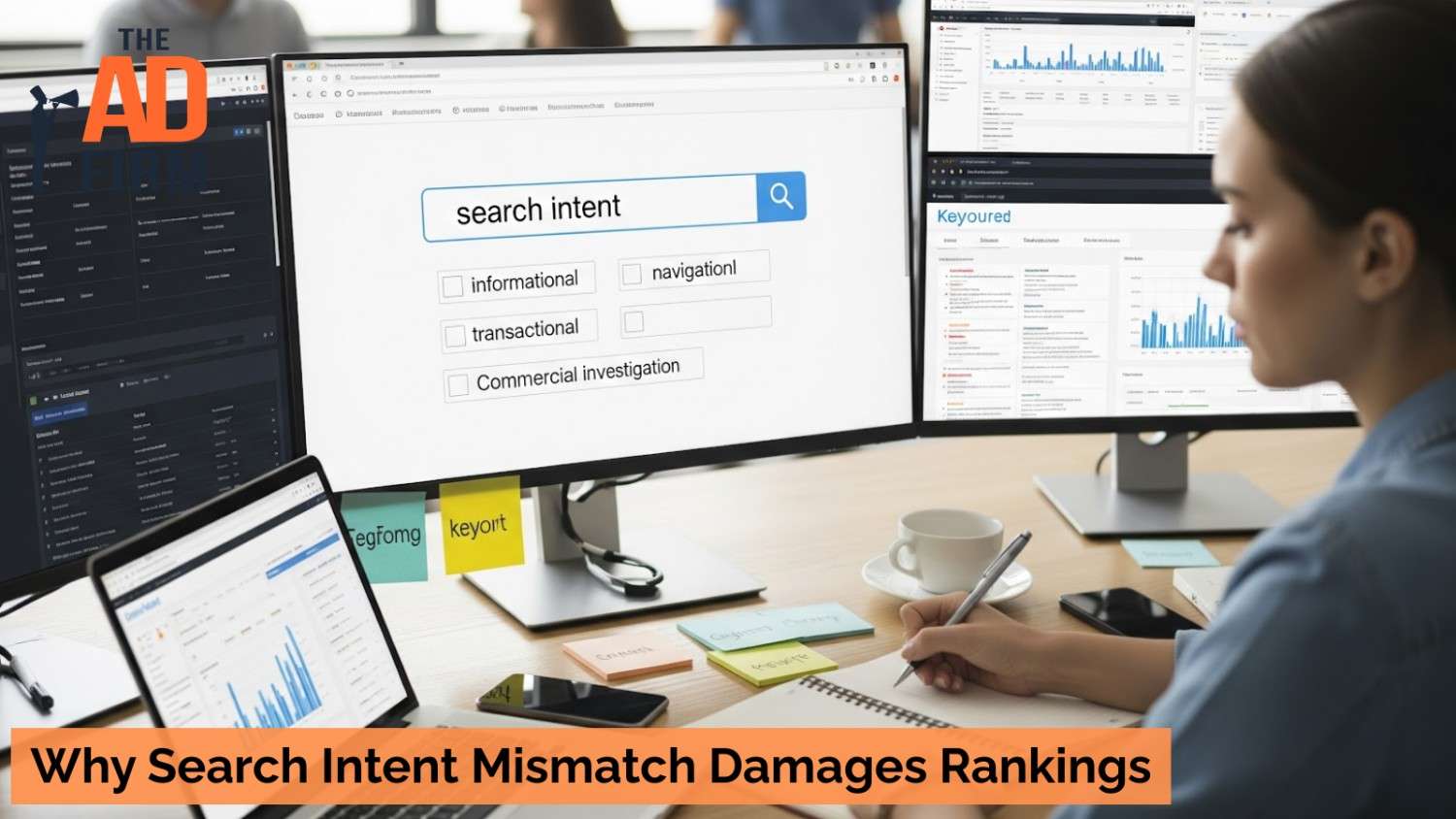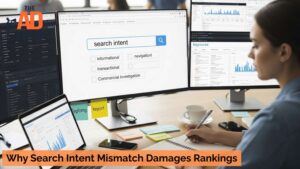Search intent is what someone truly wants when they type a query into Google. It’s not just about the words they use, but the goal behind those words, whether they aim to learn, compare, or make a purchase.
A mismatch occurs when your content fails to deliver what the searcher expected, even if you targeted the “right” keyword. For instance, creating a sales page for a question-based keyword can often leave visitors feeling frustrated. An experienced SEO company knows how to avoid this pitfall by matching pages with intent.
In this blog, you’ll learn why intent mismatch harms your rankings, what it looks like in practice, and actionable ways to fix it so your content attracts the right audience.
What Is Search Intent Mismatch?
Search intent mismatch occurs when your page doesn’t align with what the user was actually looking for. It often happens when keywords are chosen without considering the real purpose behind them.
Here’s a simple example: if someone searches “how to fix a leaky faucet” and ends up on a page selling plumbing services, that’s a mismatch. The searcher wanted instructions, not a sales pitch.
Google cares about this because its goal is to keep users happy. If people quickly leave your page, it signals that their needs weren’t met. On the other hand, when content satisfies intent, visitors stay, interact, and trust your site, which tells Google your page deserves higher rankings.
How Search Intent Mismatch Hurts Your Rankings
When your content doesn’t match what people expect, the damage goes beyond disappointing visitors. It sends signals to Google that your page isn’t relevant, lowers trust in your site, and makes it harder to convert traffic into paying customers. These are the three most significant ways a mismatch hurts your rankings.
Sends Negative Signals to Search Engines
When users click away quickly, Google interprets that as a sign your page didn’t meet their expectations. High bounce rates and short dwell times signal misalignment between search intent and content.
Over time, this reduces visibility and lowers rankings as Google favors pages that satisfy intent. Better-matched competitors naturally rise above you, earning stronger engagement and claiming your spot in the results.
- User actions reveal intent: A quick bounce or very little time spent on the page shows Google that visitors didn’t find what they were looking for. These behaviors signal that the content is mismatched with intent, even if the keyword itself is accurate. Over time, these signals negatively impact your page’s rankings.
- Trust in your page decreases: Google uses user satisfaction as one of its strongest measures for quality. If visitors repeatedly leave your page unsatisfied, it lowers the search engine’s confidence that your site deserves to rank. This opens the door for competitors with better-aligned content to take your spot.
- Rankings shift downward: Search algorithms prioritize results that consistently engage readers. When your pages fail to do so, they slide lower in the results. This means even if you’ve optimized keywords, Google won’t keep recommending your content if the intent isn’t matched.
- Better-matched competitors win: Competitors whose pages line up more closely with search intent naturally rise above yours. They benefit not only from higher rankings but also from stronger engagement, which further reinforces their position over time. This is especially important for ecommerce SEO, where even minor mismatches can quickly push potential buyers to competitors.
Creates Keyword Cannibalization Problems
When multiple pages target the same keyword but serve different intents, Google gets confused about which one to rank. Mixed-intent pages compete internally, splitting relevance and visibility.
Enhance Your Brand Visibility with The Ad Firm
- SEO: Enhance your online presence with our advanced SEO tactics designed for long-term success.
- Content Marketing: Tell your brand’s story through compelling content that engages and retains customers.
- Web Design: Design visually appealing and user-friendly websites that stand out in your industry.
This dilutes your site’s authority and weakens overall ranking strength. Users who land on the wrong page, such as finding a sales pitch when they expected a how-to guide, leave disappointed, which further signals a poor experience.
- Mixed intent hurts clarity: If one page explains a concept and another tries to sell a product using the same keyword, Google doesn’t know which one to prioritize. Instead of ranking either strongly, the algorithm splits visibility. This leaves both pages underperforming.
- Authority gets diluted: Search engines want one strong, clear result for each intent. When your authority is spread across competing pages, none of them gain enough traction to rank high. As a result, your site loses potential traffic that could have gone to one well-aligned page.
- Users land on the wrong content: A person looking for a tutorial may arrive on a sales page, or someone seeking pricing information might land on a blog post. This mismatch leads to poor experiences and higher rates of exit. Over time, it undermines both engagement and conversions.
- Overall performance suffers: When pages overlap and confuse intent, they all underdeliver in rankings and conversions. This wastes the resources spent creating content and makes it harder for your site to stand out. In the long run, it prevents your SEO from building real momentum.
Reduces Conversions and Engagement
Even when mismatched pages generate traffic, they rarely turn those visits into meaningful actions. Without alignment, users feel disconnected from your content.
- Visitors feel pressured too soon: A sales pitch aimed at someone still researching feels premature. Instead of drawing them closer, it creates resistance and makes them leave. This short-circuits the natural flow from awareness to decision.
- Engagement signals drop: If people don’t find what they expected, they spend less time exploring your site and skip interacting with other resources. Google views this as a sign of weak content, which reduces your visibility. Over time, this compounds the ranking problem.
- Conversion rates fall: Traffic that doesn’t align with intent may look good in analytics, but it doesn’t translate into leads, sign-ups, or sales. For businesses, this is a wasted opportunity, as they pay for visibility without earning a return. Lower conversion rates also limit the growth of your customer base.
- Marketing spend gets wasted: Whether through paid ads or organic campaigns, attracting the wrong audience costs money. If the visitors don’t convert, you’re essentially funding clicks that never bring results. Over time, this makes your overall marketing less efficient and more expensive.
Read Also: Content SEO: Matching Keywords with Intent
Amplify Your Market Strategy with The Ad Firm
- PPC: Master the art of pay-per-click advertising to drive meaningful and measurable results.
- SEO: Elevate your visibility on search engines to attract more targeted traffic to your site.
- Content Marketing: Develop and implement a content marketing strategy that enhances brand recognition and customer engagement.
How to Fix Search Intent Mismatch
Solving intent mismatch begins by understanding what searchers really expect when they type in a keyword. From there, you can adjust your content to match their needs and ensure Google sees your page as a strong, relevant result. These are the most effective ways to make that happen.
Analyze the SERPs First
Before creating or updating a page, examine the existing results that rank for your target keyword closely. This shows you what Google believes matches the searcher’s intent.
- Look for patterns in top results: If most of the first-page listings are how-to guides, that signals users want educational content. If they are product pages, it means people are closer to making a purchase. Paying attention to these patterns provides a roadmap for determining the type of content you need.
- Check for content types beyond text: Sometimes the first page includes videos, comparison charts, or FAQ-rich snippets. These formats reflect how searchers prefer to consume information for that query. By noting these details, you can create content that aligns more closely with user expectations.
- Study titles and meta descriptions: The way competitors phrase their titles often reveals intent. A “how to” keyword will feature educational titles, while transactional ones will highlight offers or pricing. Observing these clues prevents you from misjudging what searchers want.
- Use results as benchmarks: Treat the current top results as a baseline for alignment. If your page takes a very different angle, Google may not consider it a good fit. By aligning format and depth, you increase the chances of ranking alongside or above them.
Match Your Content Format
Searchers expect information to be delivered in a way that fits their purpose. A matching format ensures they instantly recognize your page as relevant.
- Choose the style users expect: For research-based queries, blog posts, and explainer guides usually perform best. For buying-intent queries, product or service pages are the right match. Selecting the proper format prevents disconnects that can drive people away.
- Use structure to guide readers: Break down content into scannable sections with clear headers, lists, or visuals to enhance readability. This makes it easier for people to absorb the information they came for. When the structure feels natural, readers stay longer and engage more deeply.
- Match depth with intent: Awareness-stage queries may only require a brief overview, while comparison or purchase-focused queries demand more detailed information. Providing the proper depth avoids overwhelming beginners or frustrating advanced users.
- Leverage multimedia where useful: Some queries benefit from video demos, screenshots, or infographics. These formats can make your content more engaging and easier to understand, ensuring you meet different learning preferences. Partnering with a digital marketing agency can also help you identify the best formats for each query, ensuring your content style always aligns with search intent.
Audit Existing Content
Reviewing what you’ve already published helps identify where intent is mismatched and what changes can fix it. Minor adjustments can make pages far more effective.
Maximize Your Online Impact with The Ad Firm
- Local SEO: Capture the local market with strategic SEO techniques that drive foot traffic and online sales.
- Digital PR: Boost your brand’s image with strategic digital PR that connects and resonates with your audience.
- PPC: Implement targeted PPC campaigns that effectively convert interest into action.
- Check if the title reflects intent: If your page title promises education but the content sells, users will leave. Aligning titles with what the page actually delivers sets the right expectations. This reduces bounce rates and improves trust.
- Review headers and subtopics: Sometimes a page drifts into unrelated angles, confusing both readers and search engines. Refining headers to follow a clear intent keeps the focus sharp. It also signals to Google that the page fully covers its intended topic.
- Update calls-to-action (CTAs): If your CTAs ask users to “buy now” when they’re still researching, you’ll lose them. Adjust CTAs to match readiness, soft prompts for awareness, and stronger ones for decision-stage users. This smooths the journey instead of rushing it.
- Fill content gaps where needed: A mismatch can also happen when vital information is missing. For example, a comparison page without pros and cons feels incomplete. Adding these details aligns the page more closely with searcher expectations.
Refine Your Keywords
Using vague or overly broad keywords often leads to an intent mismatch. Refining them ensures your content speaks directly to the right audience.
- Choose intent-driven modifiers: Adding words like “best,” “near me,” or “pricing” signals whether a searcher is researching, comparing, or ready to make a purchase. These modifiers narrow down intent and reduce confusion. They also make your targeting more precise.
- Target long-tail variations: Longer, more specific keywords usually reflect more apparent intent. For example, “best project management tools for startups” signals consideration, whereas “buy project management software” signals a decision-making process. These nuances help you align content perfectly.
- Avoid mixing intents on a single page: A single page should not attempt to rank for both educational and transactional terms. This creates confusion and weakens performance. Instead, create separate pages tailored to each intent.
- Keep refining over time: User behavior shifts as trends and search habits change. Revisiting keyword lists regularly ensures your targeting stays aligned with evolving intent. This prevents old mismatches from resurfacing and supports more substantial intent alignment, particularly when optimizing for local SEO services, where searchers expect precise, location-based results.
Align Your Content and Fix Intent Mismatch
If your rankings are slipping or your content isn’t converting, a mismatch between what users expect and what your pages deliver could be the culprit. The Ad Firm specializes in identifying these gaps and helping businesses address them, so your content not only attracts clicks but also delivers value and drives results.
Streamline Your Digital Assets with The Ad Firm
- Web Development: Build and manage high-performing digital platforms that enhance your business operations.
- SEO: Leverage advanced SEO strategies to significantly improve your search engine rankings.
- PPC: Craft and execute PPC campaigns that ensure high engagement and superior ROI.
They offer SEO services, including: auditing your existing content strategy to spot mismatches, rewriting titles/headers/CTAs to align with user intent, and refining your keyword targeting. Hence, each page fulfills the purpose visitors expect.
They also provide local SEO services to ensure your content aligns with local intent when users search for nearby solutions. Additionally, they offer website design and content format adjustments to make your pages visually appealing and user-friendly.
If you’re ready to stop wasting traffic, start matching what users want, and see measurable improvements in engagement and conversions, contact The Ad Firm to audit your content and map out a user-intent-focused content plan.





